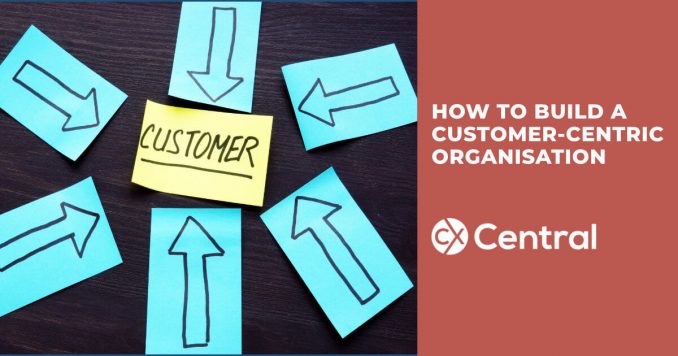
How to build a customer-centric organisation to benefit your customers and your colleagues.
It is common to hear leaders in the Private, Public and Third sector espouse “Our customers are at the centre of what we do” or similar sentiment.
Behind these words, the leader’s intent is to build a better organisation by making services easier and better for customers.
The strategy is one of transforming the organisation to become customer-centric.
Customer experience statements can be great rallying calls.
However, progressive leaders recognise the problem to solve becomes: how do you ensure such slogans live and breathe within the organisation and avoid becoming just words on a corporate screensaver?
Conventional leaders think that if their colleagues follow the “be customer-centric” instruction, the organisational ethos and values will change, and customers will reap the benefits.
This is what we refer to as the ‘wave a magic wand’ style of management!
Reality is, despite the prevailing rhetoric, customers see little evidence of their services improving, and colleagues continue to work within the stultifying red tape that prevents them from serving customers productively.
Consequently, conventional leaders become disillusioned by the various promises made by traditional change approaches to achieve their customer-centric strategy.
The result – frustration, loss of customers and poor business outcomes.
The hidden costs of conventional services
Service organisations are typically divided into separate organisational departments or channels, delivering particular services or functions.
Each has a different leader, who, in turn, has their specific targets, objectives and budgets to meet.
The assumption is that if each leader does their bit well, the whole service will improve for customers.
It is a flawed assumption.
In reality, people operate within individual departments or channels – there is no ‘work together or collaboratively’ reflected in the organisational structure.
The result – poor service delivery to customers which in turn lead to higher costs to the organisation.
When using a service, customers do not think of separate organisational departments or channels.
Nor do they value internal organisational objectives, targets and budgets.
Customers think of their service organisation holistically from the outside-in.
All they want are their circumstances, needs and issues to be understood and their specific request resolved easily and quickly.
In other words, they want value out of their interactions and time spent dealing with the organisation.
Conventional services are not designed based on how the customer wants to get value.
The relationship norm between a customer and their service provider is usually transactional.
The customer is forced to transact in a standard way through multiple front doors, often funnelled to a channel that is assumed, by the organisation, to be cheaper.
What is invisible to leaders is that these conventional designs cause poor customer and colleague experience and unnecessary operational expense.
The hidden cause is restrictive red tape – processes, practices, rules and policies have been adopted, reviewed and adapted over time.
What results is an obstructive and clumsy design that wastes time and energy and causes frustrations for customers and colleagues alike.
Such designs invite customers and colleagues to cut corners, working around the red tape so they can get things done.
A customer’s perspective
The above may sound like an interesting theory.
Our advice is that it is important to ask of any theory: could it work for me?
When we work with leaders, we help them gain a customer’s perspective of their organisations as a prelude to improvement.
The starting point is for leaders to learn first-hand what matters to their customers, understanding predictable circumstances, needs and issues.
Leaders then learn what value customers get, or don’t get from their services, and most importantly, why it is that way.
In our experience, through this experiential approach, leaders find that not one person in the organisation understands what creates value for their customers.
The cost to both the organisation and the customer by serving customers across different channels until the customer’s wants and needs are met is also not understood.
Leaders see that failing to do something or do something right for a customer (known as failure demand) causes customers to place repeat demands on the organisation until they get what they need.
They are surprised to learn that failure demand can account for as much as 80% of all customer demand for their organisation.
Equally, they are amazed to see the extent of non-value activities such as rework and duplication in their various end to end processes across channels.
Leaders learn that their inability to easily respond to differing customer needs has led them to become exemplars in short term repair not long term resolution.
They quickly understand the economics: both failure demand and non-value activities are hidden operational expenses, with no strategy or plan to remove them.
Leaders see first-hand how processes, practices, rules and policies designed into the organisation drive nonproductive behaviour, cause immense frustration and hamstring their colleagues from effectively serving customers.
Seeing the organisation, as a customer sees it, shifts their starting place from thinking they know what their problems are, to one where leaders discover they have quite different problems to solve.
Reconceiving services reduces costs and increases service capacity
We believe in the principle that all customers deserve the same high-quality service.
We also recognise that people at the frontline have the most knowledge of customer’s circumstances, needs and issues.
Working with the frontline, we use a process of experimentation that utilises their knowledge to inform improvements to be made.
As a result, services are designed that both absorb customer variety, and, counterintuitively, reduce costs.
When a service’s purpose is delivered on the first customer contact, failure demand and swathes of non-value activity disappear, and operational capacity increases.
- There are significant reductions in unwanted demand coming into the Contact Centre and other channels.
- Complaints and negative posts on social media are replaced by compliments and positive swings in advocacy.
- Customers switch to using digital services to search and fulfil, rather than progress chase (“where is my…?”).
- Churn falls dramatically because customers receiving better value from their services engenders brand loyalty.
- Staff engagement scores improve as morale rockets.
- Improved financial results follow: operational expense falls and, in sales organisations, revenue increases.
An example of how to shift the needle and build a customer-centric organisation
To illustrate, a large Australian organisation was renowned as difficult and painful to deal with.
The organisation itself understood this and had established a specialist group to change and improve service.
For several years, the organisation had tried various change approaches, each of which had failed to create any significant improvement.
This was when we received a call.
The leaders wanted to test our approach to determine whether it could be used to transform their fundamentally poor and negative customer experience reputation.
When predictable customer circumstances, needs and issues were truly understood, the real nature of what customers wanted was indisputable.
This knowledge enabled leaders to see important and counterintuitive phenomena for the first time and revealed how conventional measures had kept this business-critical information hidden.
They truly understood the problems created by the current work design, and finally had a cohesive view of what needed to be challenged to improve.
As a result, they agreed to see if a better service experience could be created to enable customers to more easily get value from their services.
The outcomes of reconceiving and redesigning the service?
After just a few months:
- The previous Net Promoter Score leapt by over a 100 point positive increase;
- Failure demand generated by the organisation reduced from an astonishing 54% to 5%;
- Staff absenteeism declined from 12% to 4%; and
- Happier customers became loyal to the organisation, and consequently, purchased more products and services.
So if you are looking to build a customer-centric organisation, making services easier and better by understanding what matters to customers in their context and enabling colleagues to work productively to service customers will unlock similar profound improvements for you and your organisation too.
Further reading and support:

